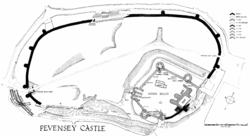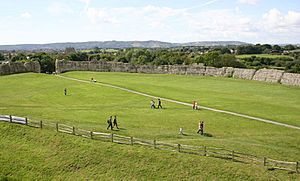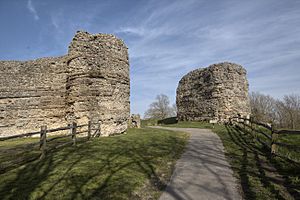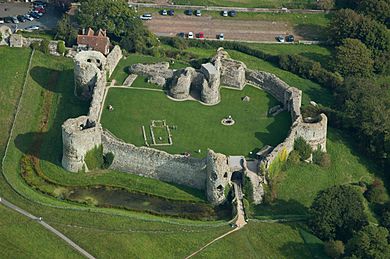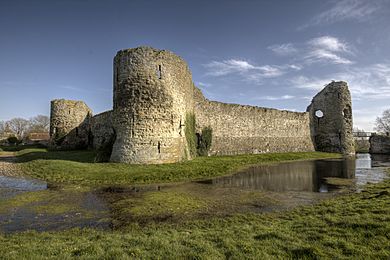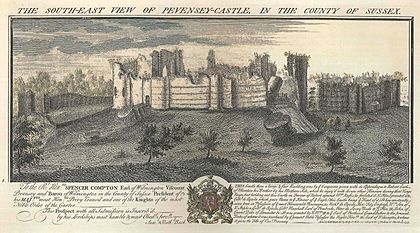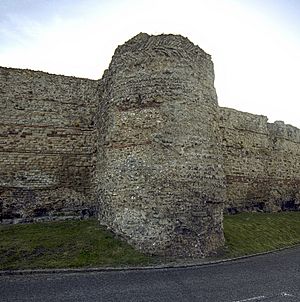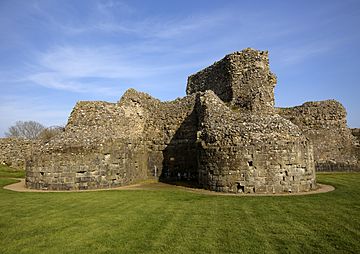Pevensey Castle facts for kids
Quick facts for kids Pevensey Castle |
|
|---|---|
| Pevensey, East Sussex | |
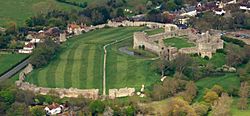
Aerial view of Pevensey Castle, showing the Norman keep and bailey within the Roman curtain wall
|
|
| Coordinates | 50°49′08″N 0°20′03″E / 50.8188°N 0.3342°E |
| Type | Castle |
| Height | c. 9.5 metres (31 ft) (outer walls) |
| Site information | |
| Controlled by | English Heritage |
| Condition | Ruin |
| Site history | |
| Built | c. 290 AD |
| Built by | Carausius? |
| In use | c. 290–471/491, 1066–mid-16th century, 1940–1945 |
| Materials | Wood, cement, flint, chalk, ironstone, greensand, sandstone |
| Battles/wars |
|
| Events | Built by Romans (c. 290), reoccupied by Normans (1066), slighted (c. 1216), abandoned (16th century), state ownership (1925), reoccupied by Allies (1940–45) |
| Garrison information | |
| Garrison | Classis Anderidaensis, Abulci (Roman era), Norman & English forces (medieval era), Home Guard, British Army, Canadian Army, United States Army Air Corps (1940–45) |
Pevensey Castle is an old castle in East Sussex, England. It was first built by the Romans around 290 AD. Back then, it was a fort called Anderitum. It was part of a chain of forts along the coast called the Saxon Shore. These forts helped protect Britain from invaders.
After the Romans left, the fort became a ruin. But in 1066, the Normans took it over. They built a strong stone keep and walls inside the Roman fort. Pevensey Castle was very important for defence. It faced many sieges, but it was never captured by force.
The castle was used until the 16th century. Then it was left to crumble. In 1925, the state took care of it. Pevensey Castle was even used again during the Second World War from 1940 to 1945. Soldiers used its old walls to set up machine-gun posts. Today, it is a ruin managed by English Heritage and is open to visitors.
Contents
What is Pevensey Castle?
Location and Size of the Castle
Pevensey Castle was built by the Romans on a raised piece of land. This land was like a small peninsula sticking out into a watery area. This made it a great natural defence spot. A small river, Pevensey Haven, ran nearby.
Over many years, the coastline changed. The sea moved further away from the castle. Now, the land around it is flat marshland. The castle is about 1.5 kilometers (1 mile) from the sea.
The castle covers a large area, about 3.67 hectares (9 acres). It is shaped like an oval. It measures about 290 meters (950 feet) long and 170 meters (560 feet) wide. Its walls and towers are the biggest of any Roman fort from that time.
How Was Pevensey Castle Built?
Roman Walls and Towers
The castle's outer wall, called the curtain wall, is very big. It still stands up to 8.2 meters (27 feet) high. When it was new, it was probably about 9.5 meters (31 feet) tall. The wall is 4.2 meters (14 feet) thick at its base.
Most of the original stones have been taken over time. What you see now is mostly the inner part of the wall. It is made of rubble and sandstone held together with mortar. There are also horizontal lines of tiles in the wall.
The castle has D-shaped towers along its wall. These towers were likely used for weapons like catapults. Ten towers still exist today. The Romans built more towers on the sides that were easier to attack.
Castle Gates
The Roman fort had two main entrances. One was on the east side, and one was on the west. The west gate was the main way in from the land. It had a single arch and towers on each side. These towers allowed archers to defend the entrance.
The east gate, which is 2.8 meters (9 feet) wide, still stands. It has been rebuilt over time. There was also a smaller gate, called a postern gate, in the north wall. This gate was a narrow, curved passage.
Inside the Castle Walls
The Romans raised the ground inside the fort. This made it level with the back of the wall. No large buildings have been found inside the Roman fort. There are signs of Roman hearths, which might mean there were wooden barracks there.
Inner and Outer Bailey
When the Normans took over, they divided the inside of the Roman fort. They created two fenced areas called the inner and outer baileys. The inner bailey was like a castle within a castle. It had its own walls, towers, and a moat. It also had a unique keep (main tower).
The stone walls of the inner bailey were built in the 13th and 14th centuries. They replaced older wood and earth defences. The inner bailey protected the most important buildings. The outer bailey was for less important buildings, like a granary.
The inner bailey's moat was very wide, over 18 meters (59 feet). A wooden bridge once connected the inner and outer baileys. Later, a stone causeway and drawbridge replaced it. The main entrance to the inner bailey was through a gatehouse. This gatehouse had two D-shaped towers. One of the basements in these towers might have been a prison cell.
Three other towers stand on the inner bailey's walls. They were built in the mid-13th century. Each had three floors. The top room in each tower had a fireplace and was probably used for living.
The keep, the main tower, is now just a stump. It was a rectangular building with seven towers sticking out. This design is not found in any other medieval castle. Documents from the 14th century say it had a kitchen and a chapel. The entrance was on the first floor, like most Norman keeps.
The keep was rebuilt several times. Large stone balls, used as catapult ammunition, can still be seen in the inner bailey. The keep fell into ruin by the 16th century. People even took stones from it to use for other buildings.
Other buildings once stood in the inner bailey. These included a great hall. The stone foundations of a small chapel are also visible. The castle's water came from a well near the chapel.
History of Pevensey Castle
Roman Fort Days

Pevensey Castle was known as Anderitum by the Romans. It was one of nine important forts on the British side of the Saxon Shore. The fort was built around 290 AD. This was part of a plan to improve coastal defences in Roman Britain.
The forts helped protect against raids from Saxon and Jute pirates. Another idea is that Anderitum was built to defend Roman Britain from Rome itself. This was because a Roman general named Carausius had rebelled against Rome.
Coins from Carausius have been found in the fort's foundations. This helps date its construction. Anderitum was a key part of the Saxon Shore forts. A Roman fleet, the Classis Anderidaensis, was likely based there. This fleet worked with other naval units to stop pirate ships.
How the Romans Built It
It took a lot of effort to build Anderitum. Experts think it took about 160,000 days of work. This means around 285 men worked for two years. Or 115 men worked for five years. Different groups of builders worked on different parts of the walls.
A huge amount of stone and mortar was needed. It would have taken 600 boat loads or 49,000 wagon loads to bring the materials. It's likely the materials came by sea.
The wall was built in sections. This can be seen from breaks in the stonework. The wall sits on strong foundations. These foundations were made of rubble and timber set into a deep ditch. Oak piles were driven into the ground.
Archaeologists have used tree-ring dating from the oak timbers to date the fort. Earlier dating methods were found to be wrong. Some old tiles found in 1906 were thought to be Roman. But later tests showed they were made around the time of the excavation. It is thought they were faked.
Who Guarded the Fort?
The Roman fort was home to a unit of soldiers called the numerus Abulcorum. These were border forces. They may have been elite troops. They might have been from allied barbarian tribes. Other Saxon Shore forts also had similar units.
After the Romans Left
Unlike other Roman forts, there was no large town outside Pevensey Castle. This was probably because the fort was on a peninsula. When the Roman army left Britain in 410 AD, people moved into the empty fort. They probably sought protection from Saxon raiders.
In 491 AD, the Anglo-Saxon Chronicle says that Saxons attacked Andredadsceaster. They killed everyone inside. It is not clear if people lived there after this event. But by the mid-6th century, a Saxon community settled there.
By the late Anglo-Saxon period, Pevensey was a fishing port. It also produced salt. In the 11th century, the village was inside the Roman walls. It had 52 residents and a harbour.
Norman Times and Beyond

By the time of the Norman conquest of England in 1066, Anderitum was a ruin. But it was still a strong place in a very important location. It had a natural harbour near the English Channel.
When William the Conqueror invaded England, his army landed at Pevensey Bay. They stayed the night in a temporary fort inside the old Roman walls. They dug a ditch and repaired the walls. The next day, they left for Hastings. The Bayeux Tapestry might show this temporary castle being built.
William chose Pevensey for its military value. He also wanted to show that the Normans were as powerful as the Romans. He built other castles near Roman sites too.
After William won the Battle of Hastings, Sussex became very important. William gave Pevensey Castle to his half-brother, Robert, Count of Mortain.
William's temporary fort became a permanent Norman castle. This happened around the 1070s. The Roman walls were repaired more. Two enclosed areas, or baileys, were created. Robert also started a small town outside the Roman walls.
The castle was first tested in 1088. Norman barons rebelled against King William Rufus. They defended Pevensey Castle. The castle was strong, but the defenders ran out of food after six weeks. They had to surrender.
Later, King Henry I took control of the castle. He used it to stop an invasion by Duke Robert of Normandy. The castle was later given to Gilbert de Clare, 1st Earl of Pembroke.
In 1147, the castle faced another siege. King Stephen blocked the castle by land and sea. Again, the castle could not be taken by direct attack. But the soldiers inside eventually ran out of food and surrendered.
Later Medieval Use
After Gilbert's disloyalty, the Crown took the castle back. They spent money on repairs and upkeep. In the 1180s, the castle had stone walls, earthworks, and wooden fences. Local areas helped maintain the fences.
New stone buildings were added in the 1190s. The keep and gatehouse might have been built then. But they were probably destroyed around 1216. This was when King John ordered the castle to be damaged. He did not have enough men to defend it from a French invasion.
Later, the wooden fences of the inner bailey were replaced with stone walls and towers. This might have happened under Peter II, Count of Savoy.
The castle faced a long siege in the 1260s during the Second Barons' War. Rebel forces tried to capture it. But the castle's defenders refused to give up. They held out for over a year. They even got supplies by sea. The siege caused damage to the castle.
Pevensey Castle remained with the Crown for another century. It was controlled by several queens. By this time, the sea was moving further away. This made it harder to get supplies by sea.
The castle was still important for defending the coast from French raids. It usually had a garrison of twenty to thirty men. These included soldiers and archers.

The castle was repaired many times in the 14th century. But poor maintenance caused it to fall apart quickly. The main buildings were rebuilt in 1301. But they were in ruins just five years later.
The Roman curtain wall was in bad shape. Sections of it had fallen down. By the mid-13th century, the outer bailey might have been impossible to defend.
Pevensey Castle was besieged for the last time in 1399. Sir John Pelham held the castle for Henry IV. The king's forces trapped Pelham inside. Pelham wrote a letter asking for help.
The siege failed. Henry IV became king. He gave the castle to Pelham as a reward. The castle was then used as a prison for important nobles. Prisoners included King James I of Scotland and Joan of Navarre, Queen of England. The castle was abandoned by the 16th century. By 1573, it was recorded as being in ruins.
Modern Use of the Castle
Queen Elizabeth I ordered the castle to be destroyed. But her order was not carried out. In 1587, the castle was used again. It became a gun position against a possible Spanish invasion. Cannons were placed there. One of these cannons, marked with a Tudor rose, is still there today.
Pevensey Castle remained a ruin until the 20th century. In the 17th century, it was almost demolished. A builder bought it to use its stones. But little work was done. The Crown took the castle back in 1660.
In 1925, the castle was given to the state as a historic monument. It was repaired.
The castle became important again in 1940 during the Second World War. British, Canadian, and American troops used it. They built machine-gun posts into the old walls. These were disguised to look like part of the original structure. Anti-tank defences were also built. The goal was to make the castle "100% tank-proof."
In 1945, the castle was returned to civilian control. The new defences were removed, but the machine-gun posts were left. They show the castle's most recent history. Today, English Heritage manages the castle. It is open to the public.
Exploring the Castle's Past
Archaeological Discoveries
Pevensey Castle has been studied by archaeologists for over 300 years. The first recorded dig was in 1710. This dig showed how the Roman wall was built. It rested on foundations of oak piles and beams. These wooden parts were still in good condition.
The Sussex Archaeological Society was founded at the castle in 1846. In 1852, two historians excavated the castle. They found Roman coins from the 4th century. They also found many stone catapult balls. The castle well was discovered around the same time.
More excavations took place in the early 1900s. They focused on different parts of the Roman fort and medieval castle. After the state took over the castle in 1926, more clearing work was done.
Work stopped during the Second World War. In the 1990s, a team from the University of Reading did more excavations. They explored the keep and the Roman fort's east side. In 2019, a geophysical survey was done. This uses technology to see what is underground without digging.
Images for kids
-
The nine British Saxon Shore forts in the Notitia Dignitatum. Pevensey Castle or Anderitum is the third one on the third row down. Bodleian Library, Oxford.
-
William the Conqueror's army building a castle at Hestengaceastra in the Bayeux Tapestry – possibly Pevensey Castle, but more likely Hastings Castle
-
Catapult or trebuchet ammunition at Pevensey Castle
See also
 In Spanish: Castillo de Pevensey para niños
In Spanish: Castillo de Pevensey para niños



